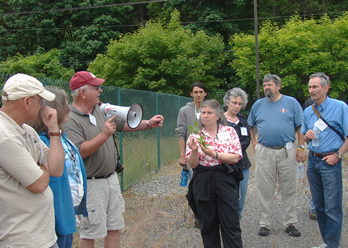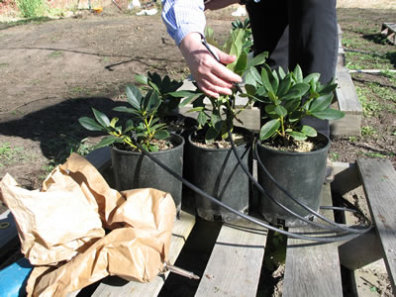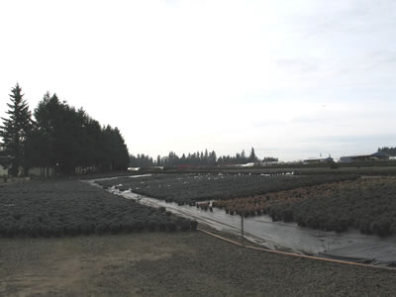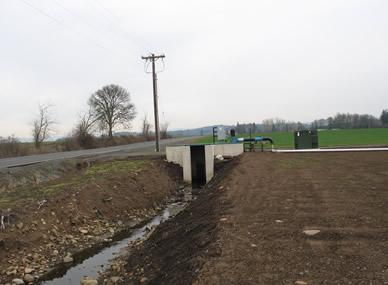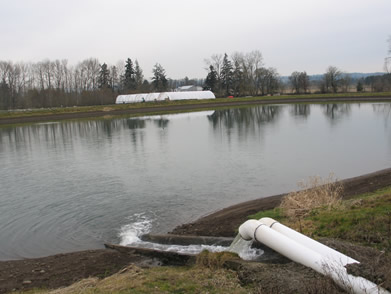Agenda
gary.maguireAgenda
- WSDA/USDA-APHIS – History and site mitigation
- WA DNR – Dan Omdal and Amy Kroll, poster presentation relating to the Sammamish River
- Return to Puyallup at about 5:00 pm
Wednesday, June 29th Workshop – Developing effective, economical and environmentally acceptable ways of limiting Phytophthora ramorum spread via contaminated nursery run-off 8:00 am – Registration 8:30 am – Welcome and Introductions 8:45 am – Overview of water issues – Mark Stanley Moderator
- Washington State – Gary Chastagner, WSU
- Eastern U.S. – Steve Oak, USDA FS
- Irrigation – Steve Tjosvold, UCCE
10:00 am – Break 10:30 am – What have we learned from water baiting? – Susan Frankel Moderator
- Biology/ecology of P. ramorum in water – Everett Hansen, OSU
Noon – Lunch and walking tour of WSU Puyallup Low Impact Development Research and Demonstration facilities led by Craig Cogger 1:30 pm – What have we learned from water baiting? Continued
- Phytophthora spp. in Water: A Southeastern Perspective – Steve Jeffers, Clemson University
- What have we learned from water baiting?– Dave Rizzo, UC Davis
- P. ramorum in water – Matteo Garbelotto, UC Berkeley
2:30 pm – Risks and impacts to WA – Panel Discussion
- Impacts of P. ramorum on the nursery industry – Dave Jarzynka, Briggs Nursery
- Sudden Oak Death potential impacts to log exports – John Browning, Weyerhaueser Co.
3:00 pm – Break 3:30 pm – Approaches to reduce the risk of spreading inoculum in water – Marianne Elliott Moderator
- Constructed Wetlands, Slow Sand Filtration, & Phytophthora spp. removal – Sarah White, Clemson University
- Water treatment options – Dustin Meador, Univ. of Florida
- Sublethal neurotoxic effects of copper on juvenile salmonids – Jenifer McIntyre, WSU
5:00 pm – Adjourn Thursday, June 30th – Disrupting the water pathway: Recommendations for prevention of P. ramorum spread via water Task: Discuss recommendations to prevent new P. ramorum introductions via water 8:30 – UK update – unknown risks? – Gary Chastagner, WSU 9:00 – Discussion of recommendations for positive water, notification –Gary Chastagner, WSU 10:00 – Break 10:30 – Preventing run-off – nursery scenarios – small groups – Marianne Elliott, WSU 12:00 – Lunch 1:00- Report out – share solutions 2:00 – Questions & answers – Steve Tjosvold and others Break Research, education, outreach and other needs – Susan Frankel, USDA FS Meeting wrap up – next steps 4:00 pm Adjourn
Photo Galleries
gary.maguirePreventing the Spread of Phytophthora ramorum via Water
gary.maguirePreventing the Spread of Phytophthora ramorum via Water:
Research and Coordination Workshop & Best Management Practices Meeting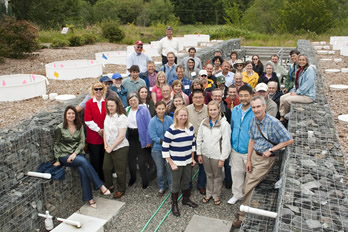
Location: Allmendinger Conference Center Washington State University Research and Extension Center 2606 West Pioneer Puyallup, WA 98371 Dates: June 28-30, 2011 Organized by: Gary Chastagner, Washington State University and Susan Frankel, USDA-Forest Service, Pacific Southwest Research Station Sponsored by: Washington State University and the California Oak Mortality Task Force
Local Arrangements: Gary Chastagner, 253-445-4528, chastag@wsu.edu and Marianne Elliott, 253-445-4596, melliott@puyallup.wsu.edu
Preventing the spread of Phytophthora ramorum via water was the focus of a two and a half day workshop attended by over 50 regulators, researchers, and industry representatives from the Western and Southeastern U.S., and Washington DC. The workshop’s mission was to coalesce research, management and regulations to develop effective, economical and environmentally acceptable ways of limiting P. ramorum spread via contaminated nursery run-off. The group visited a Gig Harbor retail nursery site where P. ramorum had leaked out of the nursery and infected riparian salal plants to review treatments and mitigations. Formal talks covered the incidence and location of P. ramorum recovery from waterways, water baiting techniques, risks and impacts for WA, and treatments to reduce the risk of spreading inoculum in water. Research and education/outreach needs identification, group exercises and discussion concentrated on nursery treatments and water management, monitoring, and notification of downstream users of contaminated water.
Contact: Gary Chastagner, 253-445-4528 | WSU Puyallup Research & Extension Center, 2606 West Pioneer, Puyallup, WA, 98371-4998 USA Last updated January 2, 2013
Events
gary.maguireEvents
Upcoming events
No events are scheduled at this time.
Past events
June 28-30 Preventing the spread of Phytophthora ramorum via water. Allmendinger Center, WSU Puyallup
July 29 2010
Stream monitoring pilot study meeting and lunch. We will discuss the results from 2010 and plan for the 2011 monitoring. Email Marianne if you plan to attend.
10 AM – 2 PM Allmendinger Center, WSU Puyallup
January 27, 2010
August 27, 2009
Establishing an Enhanced Monitoring Program for Phytophthora Pathogens in Western Washington Streams At this meeting we will determine the level of interest and plan a program of stream monitoring for Phytophthora ramorum and other Phytophthoras in Western Washington. This may also serve as a template for monitoring other plant pathogens that can be moved in water.
8:30 am – 3:00 pm Allmendinger Center, WSU Puyallup
2003 Sudden Oak Death Meeting at WSU Puyallup (Video archive)
Presentations
Download presentations from past events here for use in your own training sessions:
Publications
gary.maguirePublications
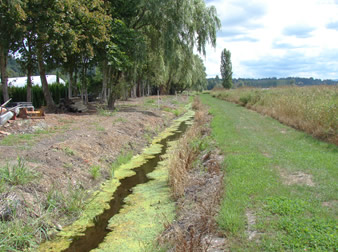
- Sudden Oak Death Program
- Monitoring Streams – Volunteer Information
- How to keep Phytophthora ramorum out of your Nursery
Posters
- Turning over a clean leaf – how to protect your garden from pest and disease invaders
- Download the pdf for printing:
- Nursery Poster English
- Nursery Poster Español
- Or contact Marianne Elliott to obtain the print version (24″ x 16.5″)
Foliar Symptoms-Photos
gary.maguireQuestions to determine the likelihood of P. ramorum infection
gary.maguireQuestions to determine the need to submit a homeowner sample in Washington State
Contact: Gary Chastagner, 253-445-4528 | WSU Puyallup Research & Extension Center, 2606 West Pioneer, Puyallup, WA, 98371-4998 USA
Last updated January 2, 2013
Plants photo gallery
gary.maguirePlants photo gallery
| Confirm that nursery stock is purchased from a licensed, certified shipping nursery or that material is propagated on-site. | |
| Inspect all incoming nursery stock (buy-ins, transfers, and returns) prior to introduction into the nursery facility. Avoid mixing incoming plants with existing stock until plants have been examined for disease symptoms by trained personnel. | 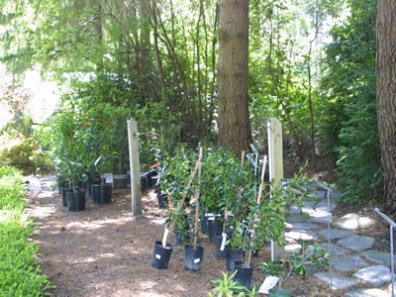 |
| For buy-ins of high risk plants, suspend the use of Phytophthora specific fungicides on 10% or 100 plants, whichever is smaller, for a 2 month period. This will show if fungicides used by the seller were suppressing symptoms prior to purchase.High risk plants for P. ramorum include rhododendron, camellia, pieris, kalmia, and viburnum. | 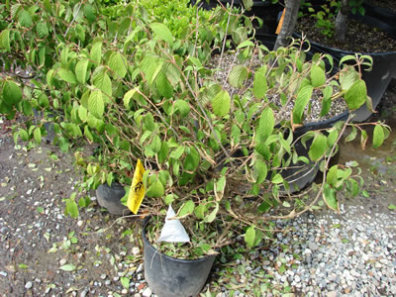 |
| Arrange plants to minimize damage caused by P. ramorum should it enter the nursery.Avoid mixing high-risk genera (Rhododendron, Camellia, and Viburnum) with other host and non-host plants. It is recommended to keep a 2 meter break between high risk plants and other material. | 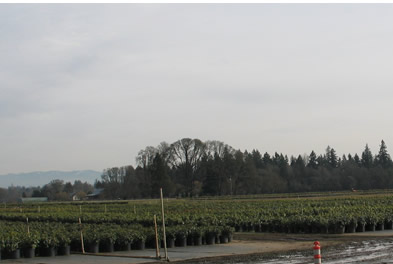 |
| Manage weeds on the nursery site as they could serve as alternate hosts for diseases or be potential reservoirs for disease organisms. | 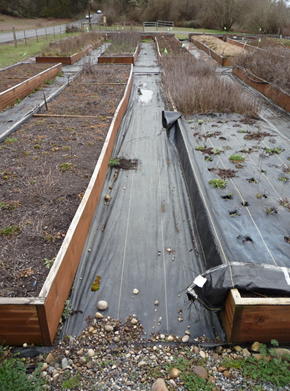 |
| Back to Managing Phytophthora diseases in the nursery | |
Water management photos
gary.maguireWater management photo gallery
| Phytophthora can spread from cull piles where diseased plants are disposed of, especially if the site is muddy with standing water. Spores can be tracked throughout the nursery on vehicle tires and workers shoes.Ensure that runoff from cull piles is directed away from areas such as roads, growing beds, soil components and mixing areas, and especially from areas containing high-risk host plants to prevent contamination by spores. | 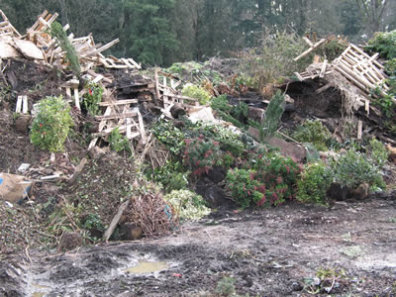 |
| Avoid overhead irrigation. If you use overhead irrigation, ensure that leaf wetness of 12 hr or more is minimized. Irrigate in the morning to allow leaves to dry as soon as possible. | 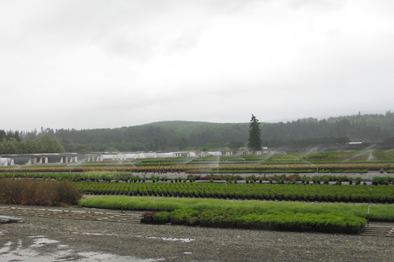 |
| Drip irrigation saves water and reduces the chances of infection. However, if the soil or media stays wet and in contact with the plant, infection may result. | |
| Dirt roads are prone to flooding in the wet climate of the Pacific Northwest.Standing water in roadways is a good environment for Phytophthora and Pythium, whose spores can be spread on vehicle tires. | 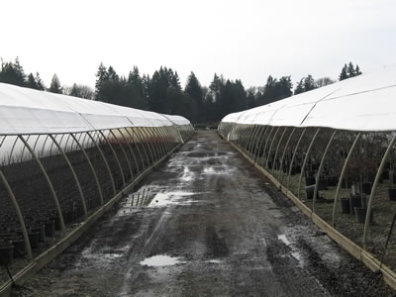 |
| To prevent flooded areas where waterborne diseases can accumulate, a level, graveled road is the best option. | 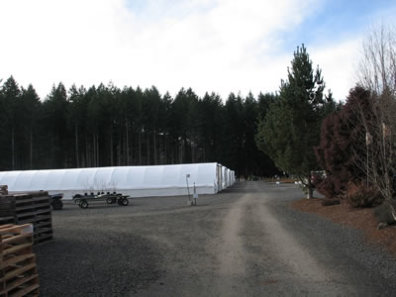 |
| Avoid letting water accumulate under or around blocks of containerized nursery stock. Allowing plants to stand in water increases the chances for Phytophthora root infection. | 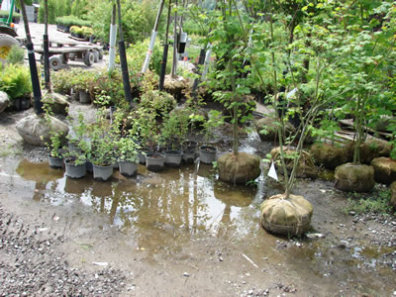 |
| These plants are set out on a sloped area, allowing water to run off rather than accumulate.However, water should be diverted from hillsides populated with P. ramorum host plants since spores move in water. Place these plants at the bottom rather than the top of the slope. | |
| Disease can be spread throughout a nursery in recycled irrigation water.Irrigation water from any source other than well or municipal water should be monitored for P. ramorum if the pathogen is detected in or near the nursery grounds. | |
| Retention ponds should be tested periodically for presence of Phytophthora and Pythium species. It is a good idea to monitor for Phytophthora species in general to reduce damage caused by these diseases. | |
| Water in ponds can be treated with chemicals, such as sodium hypochlorite, to eliminate disease organisms. | 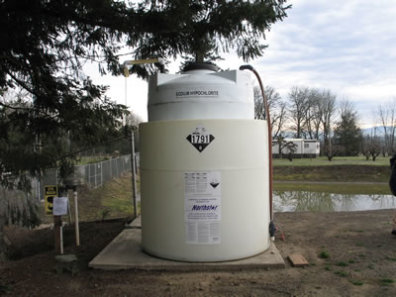 |
| Back to Managing Phytophthora diseases in the nursery |




